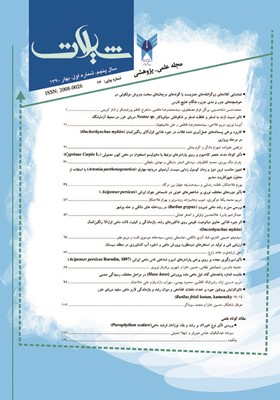شناسایی کلادهای زوگزانتلههای همزیست با گونههای مرجانهای سخت بهروش مولکولی در حوضچههای جزر و مدی جزیره هنگام خلیج فارس
محورهای موضوعی : نشریه فن آوریهای نوین در توسعه آبزی پروری
کلید واژه: خلیج فارس, جزیره هنگام, روش مولکولی, زوگزانتلههای همزیست, مرجانهای سخت,
چکیده مقاله :
با توجه به اهمیت Zooxanthellae در پدیده سفید شدگی جوامع مرجانهای آبسنگ ساز و بهمنظور روابط زیستی بین مرجانهای آبسنگ ساز و جلبکهای همزیست آنها در خلیج فارس و همچنین چگونگی پایداری و بقا مرجانها در برابر شرایط نامساعد و سخت زیستمحیطی، تعیین و شناسایی تک سلولیهای دو تاژکی از جنس Symbiodinium بهعنوان هدف اصلی از انجام این تحقیق در نظر گرفته شده است. 5 گونه مرجان Siderastrea savignyana، Psammocora superficialis،Coscinaraea columna ،Anomastrea irregulariis، Cyphastrea serailiaاز حوضچههای جزر و مدی جزیره هنگام در خلیج فارس (جنوب جزیره قشم) جمعآوری گردید. زیر واحد بزرگ ریبوزومی s28 با استفاده از واکنش زنجیرهای پلیمراز (PCR) تکثیر شده و سپس آنالیز فیلوژنی سکانس زیر واحد بزرگ ریبوزومی بر اساس نرمافزارهای PAUP و Clustal X مورد تجزیه و تحلیل قرار گرفت. بر روی مرجانهای مورد مطالعه در جزیره هنگام دو کلاد متفاوت شناسایی گردید که کلاد D در 3 گونه مرجان Coscinaraea columna، irregulariis Anomastrea، Cyphastrea serailia و کلاد C در 2 گونه Psammocora superficialis، Siderastrea savignyanaوجود داشته است. این مطالعه مشخص نمود که بهدلیل وجود استرسهای محیطی و نوسانات شرایط زیستی در ناحیه ساحلی بهخصوص در حوضچههای جزرومدی، وجود کلادهای متفاوت و مقاوم D و C طبیعی بهنظر میرسد.
Considering the importance of Zooxanthellae in bleaching phenomenon, and in order to understand the correlation between Coral reefs and symbiosis algae in the Persian Gulf and strength of reefs against environmental conditions, Symbiotic algae were studied. Materials and Methods: Samples of coral species (Siderastrea savignyana, Coscinaraea columna, Anomastrea irregulariis, Cyphastrea serailia, and Psammocora superficialis) were collected from intertidal pools of Hengam Island in Iranian side of the Persian Gulf (south of Qeshm Island-Hormozgan province). Partial 28S nuclear ribosomal (nr) DNA of Symbiodinium were amplified by Polymerase Chain Reaction (PCR) and then PCR products were analyzed the phylogenetic analyses of the LSU DNA sequences based on PAUP and Clustal X software. Results: The results showed that there are at least two clades of Symbiodinium from Hengam Island corals, Clade D was detected from C. columna, A. irregulariis, C. serailia species while clade C just found in S. savignyana, P.superficialis. Conclusion: This study showed that the persistence of clade D and clade C Symbiodinium in Hengam Island is due to high environmental stresses in the intertidal pools.
_||_

